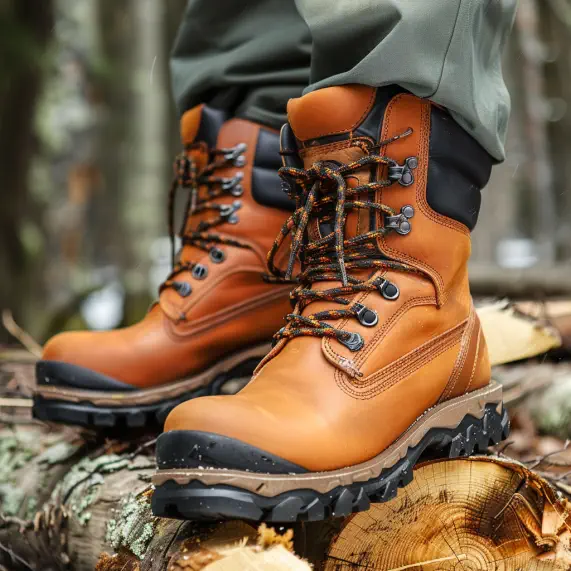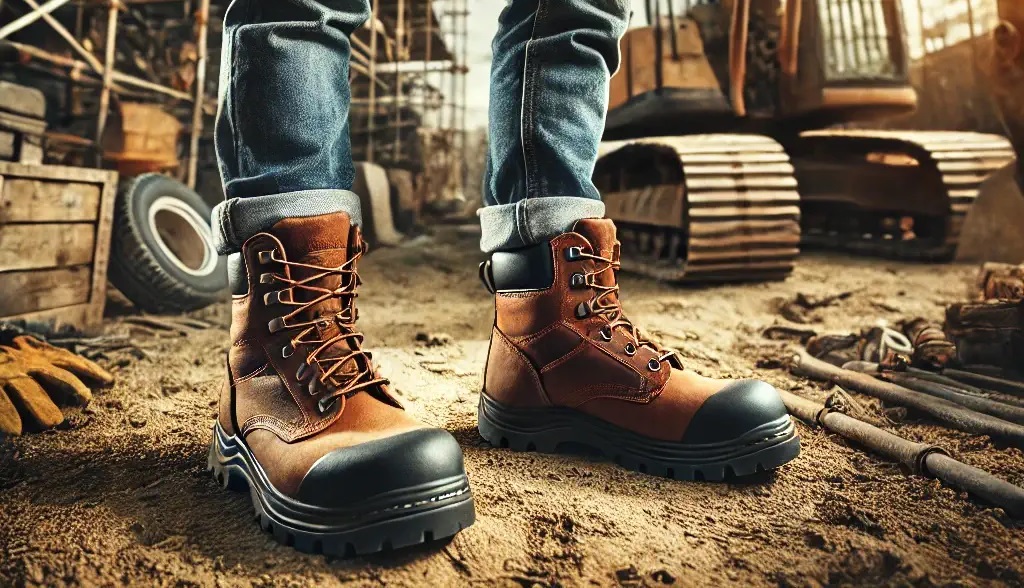Ever stepped into a muddy worksite or walked down a rocky trail and wished your boots didn’t cost so much? Let me introduce you to Ridgecut boots—the tough, durable footwear that doesn’t break the bank. I’ve seen my cousin, a cattle rancher, wear his Ridgecut work boots through the hot Texas summers, and they’ve held up like champs. These boots, made by Tractor Supply Co., are built for people who know hard work. In this guide, I’ll show you which styles offer the best safety, which ones are the most comfortable, and whether they really live up to the promise. Stick around, and if you’re looking for boots that work as hard as you do, let’s dive in.
Who Makes Ridgecut Boots?
So, who makes these tough boots that so many people love? Here’s the scoop: These boots come from Tractor Supply Co. You know the place—where your grandpa bought his first overalls and where I still get feed for my chickens. These boots are designed by folks who understand hard work.
Tractor Supply has been around since 1938. They don’t just sell anything. I’ve seen these boots survive everything from hay bales to hydraulic fluid spills. Are they fancy? Not at all. But like your trusty old pickup truck, they’re built to work without any drama. And the best part? They’re affordable. Wondering if they hold up in real life? Let’s look at the good and the not-so-good and hear what my cousin thinks of his Ridgecut steel-toe boots.

Are these Boots Good? A Quick Verdict
Are theset boots really worth the money? Well, my cousin wore his Ridgecut work boots for three years on cattle drives. His knees gave out before the soles did. That’s a good sign, right?
The Good Stuff:
✔️ Affordable: They cost less than big-name boots, but still get the job done.
✔️ Built to last: With tough soles, strong seams, and comfy insoles, these boots will stick with you all day.
✔️ Lots of options: Whether you need steel toes or boots for the ranch, Ridgecut has a style for you.
The “Eh, Not Perfect” Stuff:
❌ Break-in time: At first, they might feel a bit stiff—wear thick socks.
❌ Not for extreme cold: The insulation is light, so wear wool socks in chilly weather.
❌ Sizing can be tricky: Order a half-size up. Trust me, I’ve learned the hard way.
They aren’t fancy, but if you need boots that work as hard as you do, Ridgecut is a solid choice. I own a pair of the toughwear boots myself, and they got me through a crazy monsoon last summer. If you’re still not sure, let me walk you through my experience with these boots—especially the Lowcountry style I wore during a hike through a Georgia swamp.
Where Are These Boots Made?
Here’s the truth—They aren’t made in the U.S. but are made with American workers in mind. Most of them come from overseas factories in places like Vietnam or China. But don’t worry—they go through plenty of testing to make sure they’re tough enough for the job. I’ve seen them perform on muddy farms, at construction sites, and even during outdoor adventures, so I know they’ll hold up.
Are they made locally? No. But neither is your smartphone, and you use that every day. The key is the quality that Tractor Supply puts into each pair before it hits the shelf. They test these boots to make sure they meet U.S. standards. Still unsure? Let me tell you about how my Ridgecut Lowcountry boots held up in Georgia’s Okefenokee Swamp.
Ridgecut Boots Review: Top Picks
Let’s talk about these comfortable boots. I’ve used them in barns, swamps, and one wild thunderstorm, so here’s what I think about the top styles:
Ridgecut Toughwear Boots:
These boots saved my feet during a heavy downpour. They’re waterproof and slip-resistant, perfect for wet, slippery environments. My cousin uses them for fence repairs in Louisiana and says, “Dry feet, happy life.” But, don’t expect them to breathe like sneakers—they’re more like rain boots with a strong work ethic.
Ridgecut Work Boots (Steel Toe):
If you need steel-toe protection, these are the ones. My neighbor, a welder, calls them his “insurance policy.” The steel toe is strong and rated for electrical hazards. They’re a bit heavier than others, but when safety is important, you’ll be glad you have them.
Ridgecut Rancher Boots:
These are the cowboy-style boots of the bunch. They’ve got a snug heel, sturdy stitching, and a roomy toe box. Perfect for long days on the ranch—or even for a quick stop at a cattle auction. A buddy of mine wore his to both a wedding and a rodeo. “Dress ‘em up, beat ‘em up,” he says. Just remember to break them in slowly—new ones feel like stiff jeans.
Ridgecut Lowcountry Boots:
These are my personal favorite for hikes. They’re lightweight, flexible, and feel almost like sneakers, even after walking 10 miles through the Okefenokee Swamp. If your days go from barn work to errands, these are the boots you want.
Ready to make sure your Ridgecut boots last as long as your favorite pair of jeans? Let’s talk about that…
How to Make They Last Longer?
Boots are an investment. You want them to last, right? I’ve learned a few tricks to keep my Ridgecuts in great shape:
- Break them in slowly: Don’t rush it. Wear thick socks around the house for a few nights. Trust me, my Ridgecut boots went from uncomfortable to comfy after a few evenings of wearing them.
- Clean them well: Mud is the enemy. After a long day in the barn, I hose mine off and scrub them with an old toothbrush. Let them air dry—never use heat, as it can crack leather.
- Feed the leather: About once a month, I rub mink oil on the leather. It keeps the boots supple and water-resistant. This small step has helped my rancher boots last through three harsh winters.
- Rotate your boots: Boots need rest too. If you have more than one pair, rotate them. My neighbor swears this helps his steel-toe boots last longer. “Like tires,” he says, “rotate them and they’ll last longer.”
Treat your Ridgecut boots well, and they might outlast your lawnmower. Now, let’s talk about where to get them…
Where to Buy These Boots?
You don’t have to search far for these boots. They are available at Tractor Supply Co.—the same place you go for garden tools or animal feed. I bought my first pair in-store, and let me tell you, it’s worth trying them on before buying. I learned this the hard way, but the staff helped me find the right size. Pro tip: Go in around noon on weekends to avoid the busy crowds.
If you can’t make it in person, don’t worry. Their website has you covered, but I still recommend trying them on in-store, especially for styles like the steel-toes and rancher boots.
Final Thoughts: Who Should Buy Ridgecut Boots?
These boots aren’t for everyone. They’re not high-end fashion—they’re the reliable tool in your toolbox. If you’re a weekend warrior, a rancher on a budget, or someone who needs steel-toe boots without breaking the bank, Ridgecuts are a solid option.
My cousin’s Ridgecut boots? Still going strong after years of tough work. My welder neighbor’s steel toes? Outlasted his last two trucks. But if you’re working in extreme conditions, like freezing temperatures or 12-hour welding shifts, you might want to splurge on a pricier pair.
For under $100, They are like a loyal farm dog—low-maintenance, always ready to work, and there when you need them. Not flashy, but they’ll stick with you through thick and thin. Ready to try them? Head to Tractor Supply—you’ll be glad you did.
FAQs
“Are these boots good for construction work?”
Yes. My neighbor’s worn them on construction sites for years, and they’ve held up well. Just be aware—they won’t keep your feet warm in extreme cold.
“Do they come in wide sizes?”
Yes! Both the work boots and rancher styles offer wide fits. They’re like your favorite pair of jeans—snug, but comfy.
“Can I waterproof Ridgecut boots?”
Most styles come pre-treated, but a $10 waterproofing spray adds extra protection. It’s like a raincoat for your boots—extra protection never hurts.

Marry Christin, a passionate fashion designer and style enthusiast. Fashion isn’t just my profession—it’s my addiction! Along with my expert team, I bring you honest reviews of the latest fashion trends, including shoes, boots, sandals, dresses, and more.

